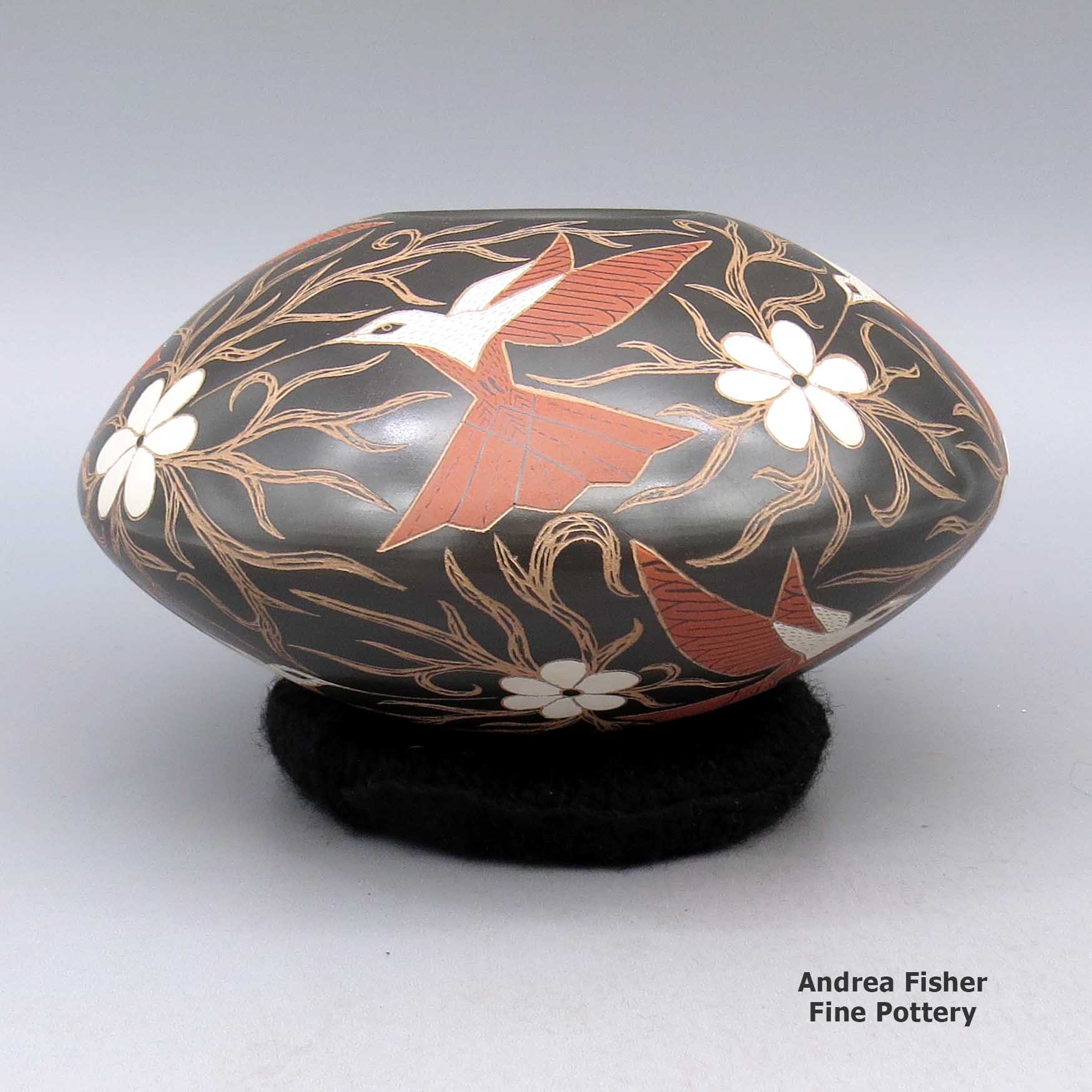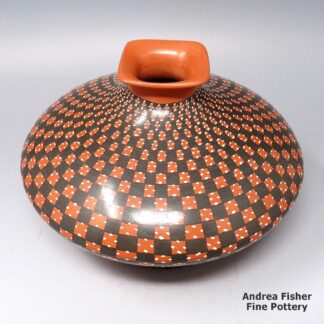| Dimensions | 5.75 × 5.75 × 4 in |
|---|---|
| Measurement | Measurement includes stand |
| Condition of Piece | Very good, normal wear |
| Signature | Elicena Cota |
| Date Born | 2022 |
Elicena Cota, zzcg2j320m3, Polychrome jar with hummingbird, flower and branch design
$275.00
A polychrome jar decorated with a contemporary sgraffito-and-painted hummingbird, flower and vine design
In stock
- Product Info
- About the Artist
- Home Village
- Design Source
- About the Shape
- About the Design
- Family Tree
Brand
Cota, Elicena
Born in 1979 in Mata Ortiz, Elicena grew up learning how to make pottery with her parents and finally struck out on her own at 17 years old. A few years later she married Efrain Lucero Jr. and they sometimes collaborate on their pottery.
Elicena's designs usually incorporate birds or dragonflies and a tree branch or vine motif that covers the entire surface of the vessel. The base designs (tree branches, vines, flowers and bird outlines) are scratched into the vessel, then the birds and flowers are painted in.
About Mata Ortiz and Casas Grandes
Mata Ortiz is a small settlement inside the bounds of the Casas Grandes municipality, very near the site of Paquimé. The fortunes of the town have gone up and down over the years with a real economic slump happening after the local railroad repair yard was relocated to Nuevo Casas Grandes in the early 1960s. It was a village with a past and little future.
A problem around the ancient sites has been the looting of ancient pottery. From the 1950s on, someone could dig up an old pot, clean it up a bit and sell it to an American dealer (and those were everywhere) for more money than they'd make in a month with a regular job. And there's always been a shortage of regular jobs.
Many of the earliest potters in Mata Ortiz began learning to make pots when it started getting harder to find true ancient pots. So their first experiments turned out crude pottery but with a little work, their pots could be "antiqued" enough to pass muster as being ancient. Over a few years each modern potter got better and better until finally, their work could hardly be distinguished from the truly ancient. Then the Mexican Antiquities Act was passed and terror struck: because the old and the new could not be differentiated, potters were having all their property seized and their families put out of their homes because of "antiqued" pottery they made just yesterday. Things had to change almost overnight and several potters destroyed large amounts of their own inventory because it looked "antique." Then they went about rebooting the process and the product in Mata Ortiz.
For more info:
Mata Ortiz pottery at Wikipedia
Mata Ortiz at Wikipedia
Casas Grandes at Wikipedia
Contemporary Pottery
The term "contemporary" has several possible shadings in reference to Southwestern pottery. At some pueblos, it's more an indicator of a modern style of carving or etching than anything else. At San Felipe it refers to almost anything newly made there as they have almost no prehistoric templates to work from. At Jemez the situation resolved to where what makes a piece uniquely "Jemez" is the clay. Any designs on that clay can be said to be "contemporary."
About Jars
The jar is a basic utilitarian shape, a container generally for cooking food, storing grain or for carrying and storing water. The jar's outer surface is a canvas where potters have been expressing their religious visions and stories for centuries.
In Sinagua pueblos (in northern Arizona), the people made very large jars and buried them up to their openings in the floors of the hidden-most rooms in their pueblo. They kept those jars filled with water but also kept smaller jars of meat and other perishables inside those jars in the water. It's a form of refrigeration still in use among indigenous people around the world.
Where bowls tend to be low, wide and with large openings, jars tend to be more globular: taller, less wide and with smaller openings.
For a potter looking at decorating her piece, bowls are often decorated inside and out while most jars are decorated only on the outside. Jars have a natural continuity to their design surface where bowls have a natural break at the rim, effectively yielding two design surfaces on which separate or complimentary stories can be told.
Before the mid-1800s, storage jars tended to be quite large. Cooking jars and water jars varied in size depending on how many people they were designed to serve. Then came American traders with enameled metal cookware, ceramic dishes and metal eating utensils...Some pueblos embraced those traders immediately while others took several generations to let them and their innovations in. Either way, opening those doors led to the virtual collapse of utilitarian pottery-making in most pueblos by the early 1900s.
In the 1920s there was a marked shift away from the machinations of individual traders and more toward marketing Native American pottery as an artform. Maria Martinez was becoming known through her exhibitions at various major industrial fairs around the country and Nampeyo of Hano was demonstrating her art for the Fred Harvey Company at the Grand Canyon. The first few years of the Santa Fe Indian Market helped to solidify that movement and propel it forward. It took another couple generations of artists to open other venues for their art across the country and turn Native American art into the phenomenon it has become.
Today's jars are artwork, not at all for utilitarian purposes, and their shapes, sizes and decorations have evolved to reflect that shift.
About Sgraffito-and-Painted Designs
Sgraffito is the technique of etching (scratching) the surface of a pot to create a design. That "etching" can happen either before or after the piece is fired. Sometimes an artist will etch before and after, depending on the purpose.
Painting refers to making some part of a piece a different color, usually using a brush but can also be done with a cloth (slipped). Sometimes a piece is slipped completely, using various colors of clay or crushed mineral in the slip before it is etched, sometimes after.
Sgraffito-and-painted techniques are relatively recent developments in the world of traditional pottery. In the world of the Hopi, multiple male potters are also a relatively recent phenomenon and, while most learned their craft from their grandmothers, mothers and sisters, they were required to find another form to create and different decorations to work with when they went commercial. While some produced seed pots and jars decorated with sgraffito geometric designs, Thomas Polacca branched into carving, etching, slipping and painting his seed pots and a whole new form and mode of expression came into being. Many of his descendants (and others) have followed the path he created.
At Ohkay Owingeh, Alvin Curran and Tom Tapia were in similar positions: male potters in a world of female potters. Both developed their own lines of design incorporating carving, sgraffito, slipping and painting into their work, differentiating themselves from the women artists.
At Santa Clara Pueblo, Joseph Lonewolf, Camilio Tafoya, Corn Moquino and others introduced the sgraffito technique to the pueblo's potters, but then a few took it further and painted more details into their work after they'd etched it.
Many of the potters working in the Mata Ortiz area have never produced their art any other way, and many of their versions of ancient subjects are timeless.
Los Hermanos Ortiz Family and Teaching Tree - Mata Ortiz
Disclaimer: This "family and teaching tree" is a best effort on our part to determine who the potters are in this grouping and arrange them in a generational order/order of influence. Complicating this for Mata Ortiz is that everyone essentially teaches everyone else (including the neighbors), so it's hard to get a real lineage of family/teaching. The general information available is scant. This diagram is subject to change as we get better info.
Note: Los Hermanos Ortiz was the name of a music group originally composed of the Ortiz brothers and a few friends who sat in with them from time to time. The group also changed names over the years until, over time, each of the brothers drifted into the art of making pottery full time. Over time they passed that knowledge on to others in their families and in their neighborhoods. But the Ortiz brothers (and father) were among the very first Mata Ortiz potters.
- Santos Ortiz & Bertha Chacon
- Eduardo Chevo Ortiz & Hortencia Dominguez
His students:
- Eduardo Ortiz Jr.
- Eligio Ortiz
- Eusebio Chevo Sandoval & Esperanza Tena
- Hector Ortega
- Natividad Naty Ortega
- Macario Ortiz & Maria Elena Nena Lopez
- Macaria Ortiz & Gerardo Pedregon
- Julio Cesar Ortiz Sr.
- Julio Cesar Ortiz Jr.
- Santos Heder Ortiz
- Tati Eleno Ortiz
- Abigail Gaby Lopez & Pepe Marin
- Eleazar Lopez & Olivia Juarez
- Edmundo Lopez & Luz Elva Ramirez
- Ruben Lozano & Anastasia Villa
- Efrain Lucero & Antonia Andrew
Others who learned from Efrain:
- Cesar Lucero & Miriam Gallegos
- Efrain Lucero Jr. & Elicena Cota
- Maria Elena Ortiz & Raul Navarette
- Cesar Navarette
- Eli Navarette
- Jesus Navarette
- Nicolas Ortiz & Patricia Ortega
- Fabian Ortiz Ortega
- Jordi Ortiz
- Miguel Angel Ortiz
- Nicolas Ortiz Jr.
- Osbaldo Ortiz & Theresa Ortiz
- Alonzo Ortiz
- Florence Ortiz
- Salbador Ortiz (d. 1997) & Eduviges Vicki Ortiz
- Paty Ortiz & Cruz Santillan





